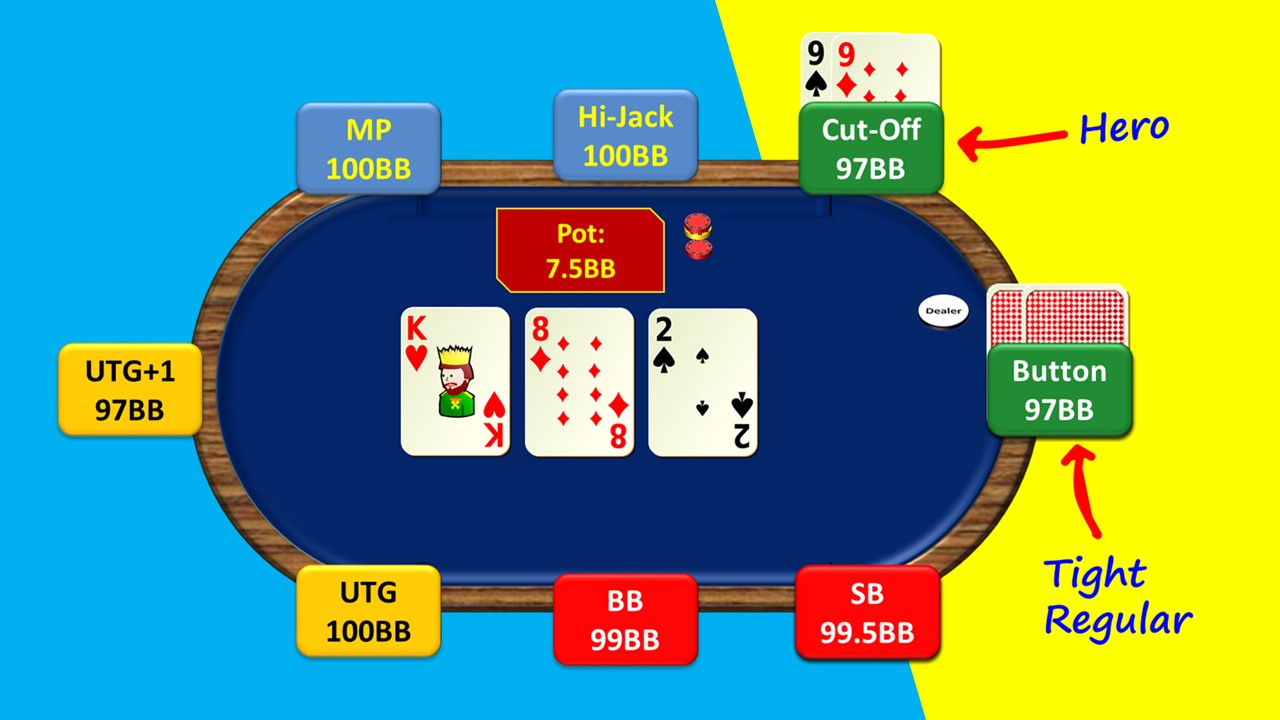Hero is in Out of Position/With the Lead/Dry Board vs Regular
In this hand, hero raised form the cut-off and a tight regular just called from the button. The flop comes up K82 rainbow. Although hero has a pair of 9s, he should just view his hand as missing the flop. It is right at the bottom of the showdown value range.
In this article, I will discuss hero’s options on how to play this hand.

Villain’s Range (Screenshot from Flopzilla)
I’ve given villain the typical microstakes regular calling range, which includes AK/AQ and pocket pairs (excluding AA-KK because villain would usually 3-bet with these).

Flop: Hero Bets
If you bet here, some NITs are going to fold everything apart from hands that beat you. He has 16 combos of AQ and 30 combos (77-33) of pocket pairs that will definitely fold. So, that’s 46 combos that will fold to a small bet.
He has 12 combos of AK that are always calling. He has 6 combos of sets that will call or raise. Therefore, there are just 18 combos that villain feels comfortable with.
There are 19 combos of pocket pairs below top pair (QQ-99).
Clearly, we have to bet here. If you check, he might just take the pot from you. Therefore, you have to bet. You will fold to a raise.
In order to size your flop bet correctly, you need to decide what you are trying to achieve with your bet or bets. For example, are you going to bet on the turn?
We want to win against the hands that we beat, which includes combos of AQ and low pocket pairs (46 combos). We also want to force some combos, that are beating us, QQ–99 (19 combos) to fold.
There are 2 ways in which we can attempt to achieve this. The first is to barrel the flop and turn and the second is to overbet the flop.
Let’s put some numbers into the Barrel Calculator.
Strategy 1: Bet ½ pot on the flop and ¾ pot on the turn
The idea behind this strategy is that the small bet (eg ½ pot) on the flop, which will get villain to fold his combos of low pocket pairs and AQ. Then, the turn bet will pressurise villain to fold QQ-99.

The Barrel Calculator says that we can bet 50% of the pot on the flop and 75% of the pot on the turn and make a profit of 46.39% of the starting pot on the flop.
That’s all well and good. Can we do any better?
Strategy 2: Bet 120% of the pot on the flop

When we overbet the pot on the flop, we can expect villain to fold all his pocket pairs below top pair. We win more money by overbetting, compared to barreling the flop and turn. Therefore, overbetting is the best strategy. It saves time as well.
Ace-High Flops
What if an Ace is on the Board instead of a King?
For example, what if the situation was as follows: Dealt to Hero (9♠9♦) versus Villain (QQ-22/AK-AQ). Flop: A♥8♦2♠.
I have already looked at this situation in Reference Hand 1. The only difference was that hero was in position in Reference hand 1. In this article, hero is out of position. Position doesn’t make any difference to villain’s starting hand range. This is because in both cases, villain just called a pre-flop raise and doesn’t 3-bet.
The conclusions from Reference Hand 1 were:
If you think villain will only fold small pairs, bet 50% Flop and Check/Fold Turn.
If you think villain will fold all pairs below top pair, bet 120% Flop and Check/Fold Turn.
If you think villain is capable of folding AQ to a big overbet (as well as all pairs below top pair), you can bet 200% of the pot on the flop.
The more combos that you can get villain to fold, the more money that you make.
Conclusion
Mathematically, overbetting on an ace- or king-high flop is the best strategy against a tight player.
You betting strategy depends on your read of villain and how tight you think he is. You do have to take your table image into consideration. However, against tight players, I don’t adjust my strategy until they adjust their strategy.
